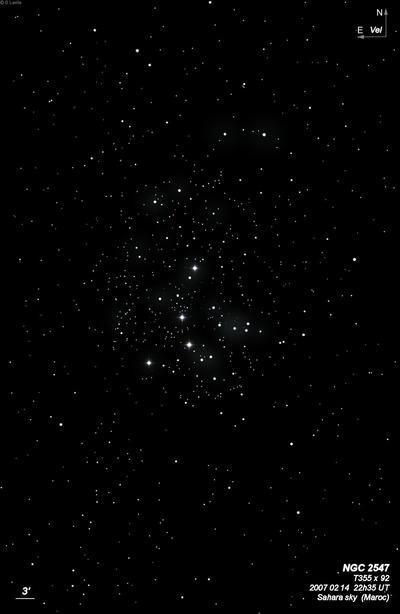
Nicolas-Louis de Lacaille discovered NGC 2547 = Lac III-2 = D 410 = h3117 in 1751-1752 using a 1/2-inch telescope at 8x during his expedition to the Cape of Good Hope. He described III-2 as "five faint stars like the letter T in nebulosity." Dunlop observed the cluster twice recording "A curiously arranged group of pretty bright small stars of mixt magnitudes. This answers to the place of 310 Argus (Bode) and is described by Lacaille as nebula with five small stars forming the letter T in it. There is no nebulosity in this place. The diameter of the cluster may be about 12'. Figure 16 [in his publication] is a very good representation of the group."
John Herschel first logged the cluster on 28 Dec 1834 and recorded "chief star 7th mag about, of a vL, loose, brilliant cluster of very scattered stars, 1 of 7th mag, 2 of 8th mag, rest 9...16th mag. Fills more than field; 100...150 stars." JH inadvertently equated this cluster with D 411 instead of D 410 and this error was copied into the NGC.
300/350mm - 13.1" (1/30/06 - Costa Rica): this naked-eye cluster to the south of Gamma Velorum (bright binocular double) is roughly 30'x20' in size. There is a very distinctive, gently curving arc of stars bowed out to the east that defines the eastern side of the central region and the brightest mag 6.5 star (HD 68478) is along this arc. Three nice pairs are to the west and NW of the mag 6.5 star (one of these pairs has a third fainter companion forming a triple). The main portion of the cluster is enclosed in two outer strings of stars that form a large "V" with the vertex to the east of the mag 6.5 star and the pair of strings increase the diameter to 30'. While scanning for NGC 2547 I ran across a bright, distinctive red star to the west (probably M3-class HD 67821).
13.1" (2/18/04 - Costa Rica): this is a very bright naked-eye cluster that includes a number of mag 7-8 stars. It appears at least 20'-25' in diameter, though the outer boundaries are pretty arbitrary. Very unusual arrangement as a number of the brighter stars form a curving arc which is bowed out towards the east and which defines the eastern border of the cluster! The brightest mag 6.5 star is within this arc on the south side of the cluster. The cluster is encased in faint reflection nebulosity, though this was not visible.
Notes by Steve Gottlieb